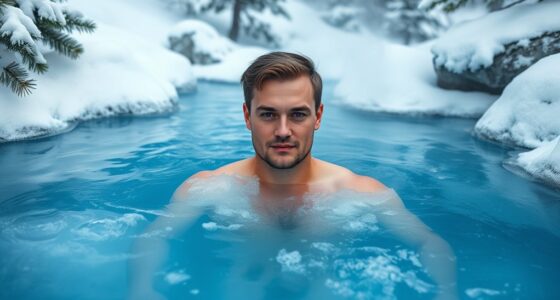Using cold plunges can help reduce inflammation by constricting blood vessels and activating anti-inflammatory responses at the cellular level. Cold exposure suppresses pro-inflammatory signals, decreases cytokine production, and promotes vasodilation cycles that clear waste and swelling. It also stimulates norepinephrine, which fights inflammation and boosts mood. To get the most benefit safely, understanding proper techniques and precautions is key—continue exploring how cold plunges can support your recovery and inflammation management.
Key Takeaways
- Cold plunges activate anti-inflammatory pathways, reducing cytokine production and limiting swelling after injury or intense exercise.
- Cyclical vasoconstriction and vasodilation from cold immersion help clear inflammatory waste and decrease tissue swelling.
- Cold exposure stimulates norepinephrine release, which suppresses inflammation and enhances mood and immune response.
- Evidence shows cold therapy supports faster recovery by decreasing pain, stiffness, and inflammation markers.
- Proper safety protocols and medical consultation are essential to maximize benefits and prevent adverse effects.

If you’re looking for a natural way to reduce inflammation, taking a cold plunge might be an effective option. Cold therapy has gained popularity not just among athletes but also for anyone seeking to manage chronic inflammation. One of the key reasons is the array of cryotherapy benefits, which include dampening the inflammatory response and promoting quicker recovery. When you immerse yourself in cold water, you’re engaging with your body’s inflammation pathways in a targeted way. Cold exposure constricts blood vessels, which reduces blood flow to inflamed tissues. This process helps limit swelling and decreases the release of pro-inflammatory substances. Once you exit the cold water, blood vessels dilate again, flushing out metabolic waste and delivering fresh oxygen and nutrients to aid healing. This cyclical process can interrupt the cycle of ongoing inflammation, helping your body reset more efficiently.
Understanding the science behind these effects reveals how cold plunges influence inflammation pathways at a cellular level. When you’re exposed to cold, your body responds by activating anti-inflammatory responses while suppressing pro-inflammatory signals. This modulation occurs through complex pathways involving cytokines and immune cells that regulate inflammation. Cold exposure also decreases the production of certain cytokines that promote inflammation, effectively dialing down the inflammatory process. As a result, you might notice reduced pain, swelling, and stiffness, especially after injuries or intense workouts. These physiological changes support the idea that cold plunges can be integrated into your recovery routine or used as a preventive measure for inflammation-related issues.
Additionally, cold plunges can stimulate the release of norepinephrine, a hormone that plays a role in reducing inflammation and improving mood. This hormonal response further supports your body’s ability to manage inflammation more effectively. Many people find that regular cold exposure not only alleviates pain but also enhances overall immune function, which can contribute to a lower baseline level of chronic inflammation. However, it’s essential to approach cold plunges with caution, especially if you have underlying health conditions. Consulting your healthcare provider ensures that this method aligns with your personal health needs.
Frequently Asked Questions
Can Cold Plunges Be Safely Used by People With Heart Conditions?
If you have heart conditions, you should consult your doctor before trying cold therapy or cold plunges. Cold exposure can affect heart health by constricting blood vessels and increasing blood pressure, which may pose risks. Always prioritize your safety and get professional advice to determine if cold plunges are suitable for your specific condition. Never proceed without medical guidance, especially when it involves your heart health.
How Long Should I Stay in a Cold Plunge for Optimal Benefits?
You should stay in a cold plunge for about 10 to 15 minutes for ideal benefits, but don’t rush. Duration guidelines emphasize listening to your body—if you start feeling numb or uncomfortable, it’s time to get out. The key is balancing exposure to maximize inflammation reduction without risking hypothermia. Trust your senses and adjust the timing accordingly; sometimes, less is more for true results.
Are There Any Risks Associated With Frequent Cold Plunges?
Frequent cold plunges can carry risks if you’re not careful. You should do a risk assessment beforehand, especially if you have heart conditions or circulatory issues. Cold exposure can affect your immune response, potentially making you more vulnerable to infections or hypothermia. Listen to your body, limit exposure time, and consult a healthcare professional if you’re unsure. Proper precautions help you enjoy benefits safely.
What Is the Best Temperature Range for a Cold Plunge?
Think of your cold plunge as a delicate dance with ice; aim for a temperature range between 50°F and 59°F (10°C to 15°C). This range balances temperature safety and water conductivity, helping you avoid hypothermia while maximizing benefits. Staying within this zone guarantees you get the therapeutic effects without risking your health. Always monitor your body’s response and adjust accordingly to keep the experience safe and effective.
Can Cold Plunges Help With Chronic Inflammation Long-Term?
Cold plunges can help reduce cold inflammation and may offer long-term benefits if used consistently. You might notice decreased inflammation markers and improved recovery over time. However, long-term effects vary for each person, and it is crucial to combine cold plunges with other healthy habits. Always listen to your body, and consult a healthcare professional before making cold plunges a regular part of your inflammation management routine.
Conclusion
So, seize the soothing, chilly plunge to combat chronic inflammation and boost your body’s resilience. Embrace the invigorating ice bath, feeling the freeze flick away fatigue and friction. With consistent cold plunges, you’ll foster a fortress of freshness, fighting inflammation fiercely. Dive into the daring, deliciously challenging ice to invigorate your immune system and ignite inner vitality. Take the plunge, and turn the tide on inflammation, one icy immersion at a time.









